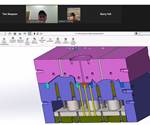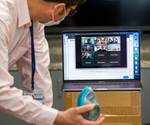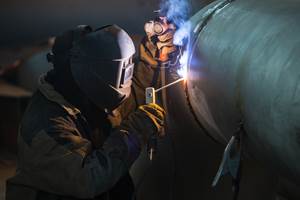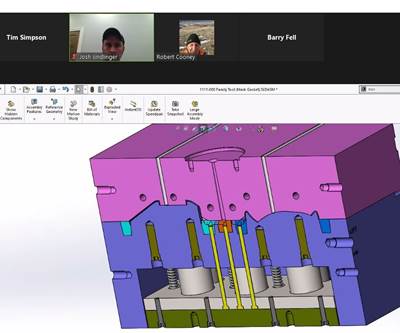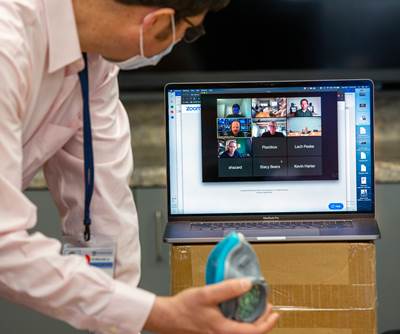The Harsh Realities of Additive Manufacturing
Now is the time to start talking about what is really holding additive manufacturing back.

An image of one of seven build failures of a piston crown that we were trying to additively manufacture in stainless steel using laser powder bed fusion. Who wants to read about AM’s failures? But talking frankly about AM’s limitations is necessary to industrialize this technology. Photo: Penn State CIMP-3D
In many ways, additive manufacturing (AM) is a bright spot in the ongoing pandemic. The ability to rapidly iterate on design ideas or locally manufacture goods on demand with minimal tooling are two distinct advantages AM has over more conventional means of manufacturing. Unfortunately, we continue to encounter the all-too-familiar limitations of AM technologies, especially when it comes to fabricating metal parts. I can’t sugarcoat it anymore — time to dive into the harsh realities of AM to shed light on where the real work is needed to industrialize it.
First and foremost is cost. The material feedstocks are significantly higher for AM. The 5X-10X difference that you see in metallic powder feedstock compared to barstock of the same material, for instance, makes it challenging to make a compelling business case for many metal AM parts. This is just one of many reasons why lightweighting and other design for AM (DFAM) methods are so important when adopting AM, as we will discuss in the coming months.
Machine cost is also a factor, although the hourly cost to run many AM systems is now par with machining centers; however, the build time is what gets you. Additively manufacturing metal parts with laser powder bed fusion, for instance, can easily take a day or two; and large, complex components may take upwards of a week or more. Multiply that amount of time by the hourly machine rate, and you will find that the operating cost for a laser powder bed fusion system to make a metal AM part can easily kill a promising application.
This brings us to the next major shortcoming, which is build speed. Granted, new laser powder bed fusion systems come with multiple lasers, which does bring the build time down substantially, but the hourly machine rate ends up being much higher given the high price tags on multi-laser systems. Sure, alternative AM technologies like directed energy deposition, binder jetting or multi-jet fusion may offer faster build speeds, but then you encounter tradeoffs with material availability, feature resolution, postprocessing and part performance, to name a few.
To make matters worse, quality can also be an issue thanks to the layer-wise fabrication that so many tout as AM’s big advantage over traditional manufacturing methods. This can lead to dimensional integrity issues, added surface roughness and even anisotropy in some AM parts, depending on the technology used. These challenges are compounded by the disconnectedness of many AM software tools for design, analysis, simulation and build prep — not to mention the dreaded STL file format, which forces an approximation on your geometry that leads to further inaccuracies in curves and surfaces as they are tessellated and replaced by a bunch of triangles. Sadly, this is the reality that we have had to deal with for 30 years. Thankfully, progress is being made to integrate AM software tools and improve file formats, but adoption lags given the challenges with upgrading or switching software systems within a large corporation.
A related issue is the size of the part that can be made with AM. While cubic-meter-scale laser powder bed fusion systems are in development, large-volume builds may necessitate using a different AM process, which again may limit material availability, feature resolution, etc. This requires knowledge of multiple AM processes and their limitations, which means continuous learning to stay apace with the changing technology. Unfortunately, manufacturing as an industry spends the least on training and educating its workforce. I recently saw data showing that manufacturing spends about half of what the healthcare/pharmaceutical industry does to educate its workers, one third of what the finance/insurance/real estate industry spends, and only a quarter of what the software/IT/telecommunications industry spends on its employees. How on earth will any manufacturing company keep up with the latest technology advances if they are not continuing to keep their employees educated?
Knowledge of AM capabilities is only one piece of the puzzle. There are new design tools for AM that engineers must learn. Meanwhile, design allowables for AM materials are limited and/or are not being readily disclosed by companies that have made the necessary, and often significant, investment in developing them. Many standards for AM are still lacking as well. Yes, there has been a flurry of activity in the past couple of years, but keeping pace and reconciling the differences among all of the new and emerging standards is a challenge for anyone in the field. This makes material and process qualification and part certification an expensive proposition; yet companies are doing it and finding ways to bring products to market.
So, there is hope, but it is easy to overpromote these successes given how rare they really are. Unfortunately, the harsh realities remain, and it is time to shine a light on them, as they do not receive enough attention. I mean, who wants to read stories of the seven times your build failed or why postprocessing doubled the cost and lead time of an AM part? Complexity is free when it comes to AM, right? No, not at all, as any seasoned AM engineer will tell you — you just have to get beyond the hype and be willing to learn (and share) the real “nitty gritty” details of AM. Those are the conversations and stories that I enjoy most, actually, and I invite you back next month as I start to explore our AM misadventures!
Related Content
8 Ways to Increase Productivity on the Manufacturing Floor
When it comes to machine shop productivity, continuous improvement depends on efficient employees, equipment and processes.
Read MoreHow to Reduce Cycle Times by 70% and More on Your Existing CNCs and Dramatically Improve Tool Life Too
By employing advanced high efficiency milling techniques for the entire machining routine, SolidCAM’s iMachining technology can drastically reduce cycle times while vastly improving tool life compared to traditional milling.
Read More10 Tips for Titanium
Simple process considerations can increase your productivity in milling titanium alloys.
Read MoreSelecting The Right Welder
Many machine shops, on occasion, have a need for welding. It may be for maintenance purposes, repair or to fill the odd contract. This story is a welding process primer for those shops whose main business isn't welding but need to know some basics.
Read MoreRead Next
Additive Manufacturing in the Age of COVID-19: Ramping Up for a Fight
Reporting from the front lines of the fight against the coronavirus, this time confronting the costs to ramp up production of needed medical products.
Read MoreAdditive Manufacturing Versus COVID-19: The Race for PPE
Reporting from the front lines of the fight against coronavirus — still deep in the trenches.
Read MoreAdditive Manufacturing vs. COVID-19: Protecting Your Ideas for Protecting Others
Reporting from the front lines of the fight against the Coronavirus – battling liability and IP issues.
Read More

